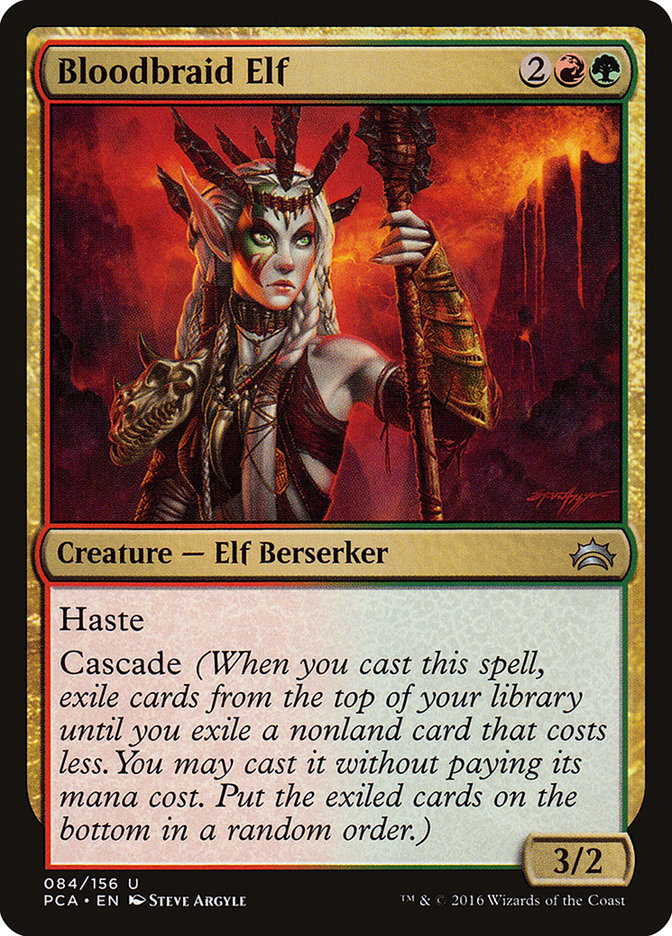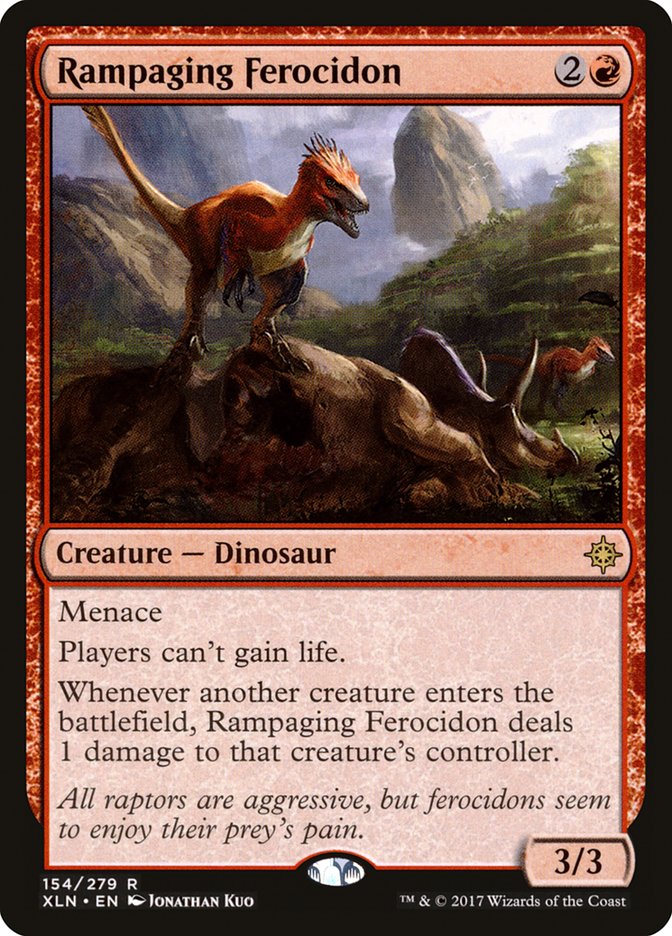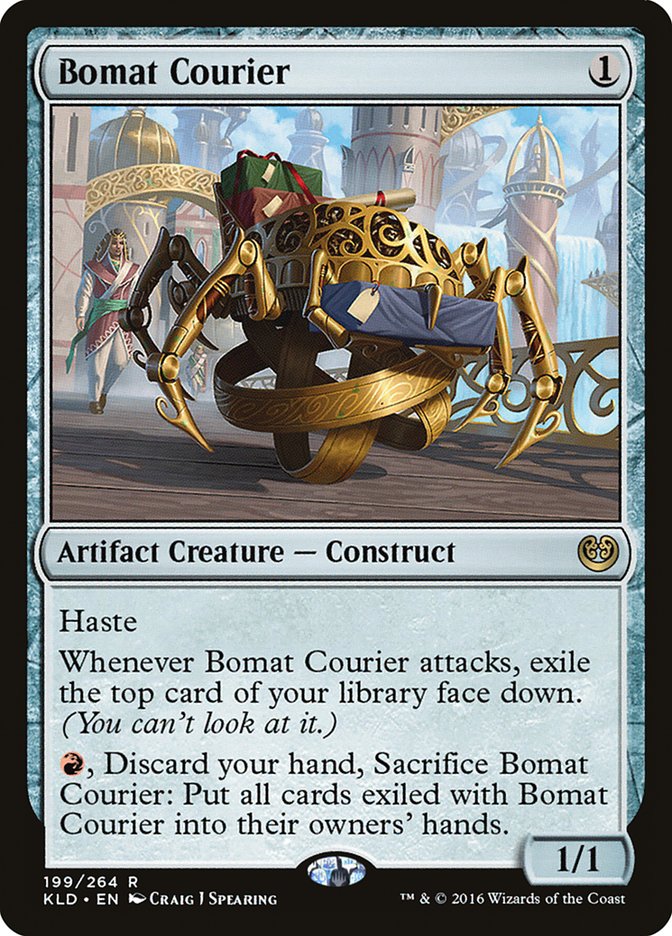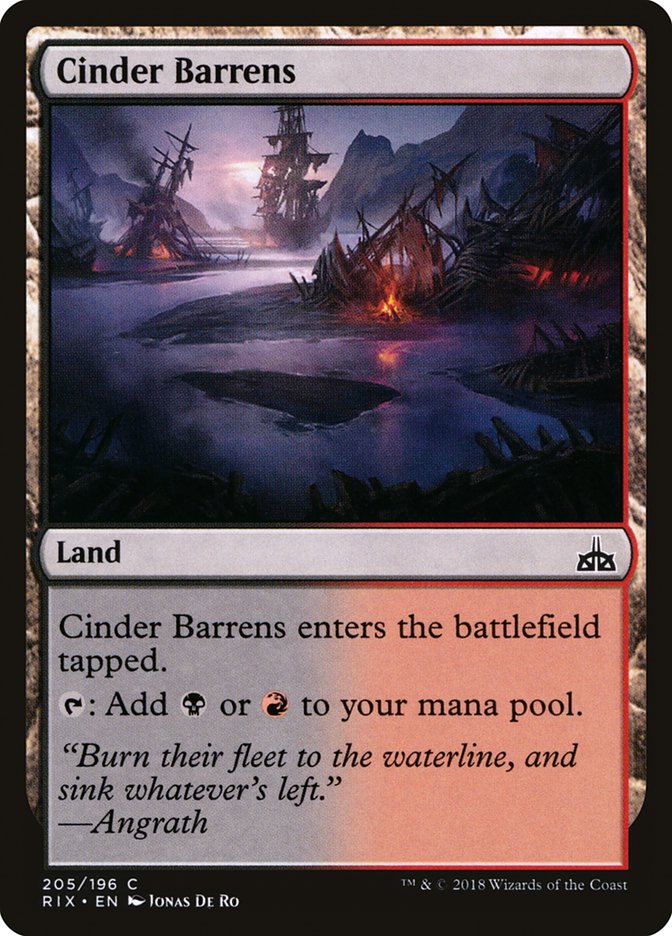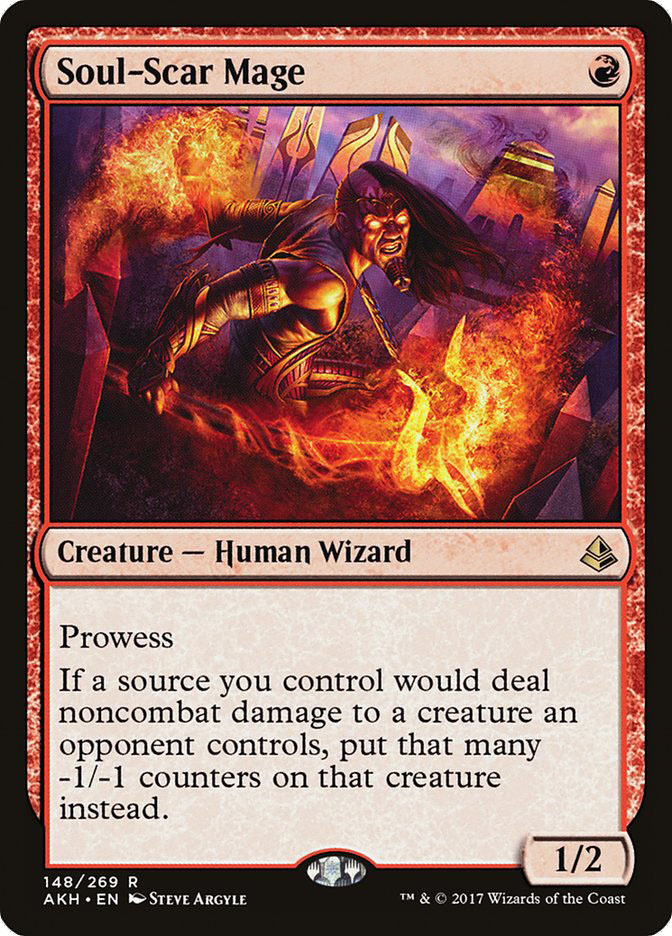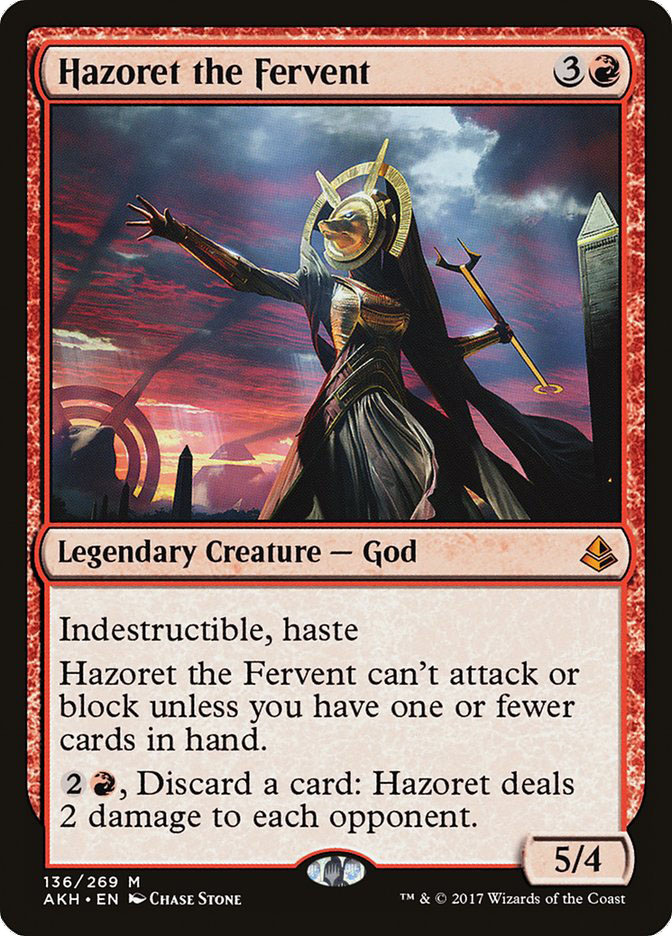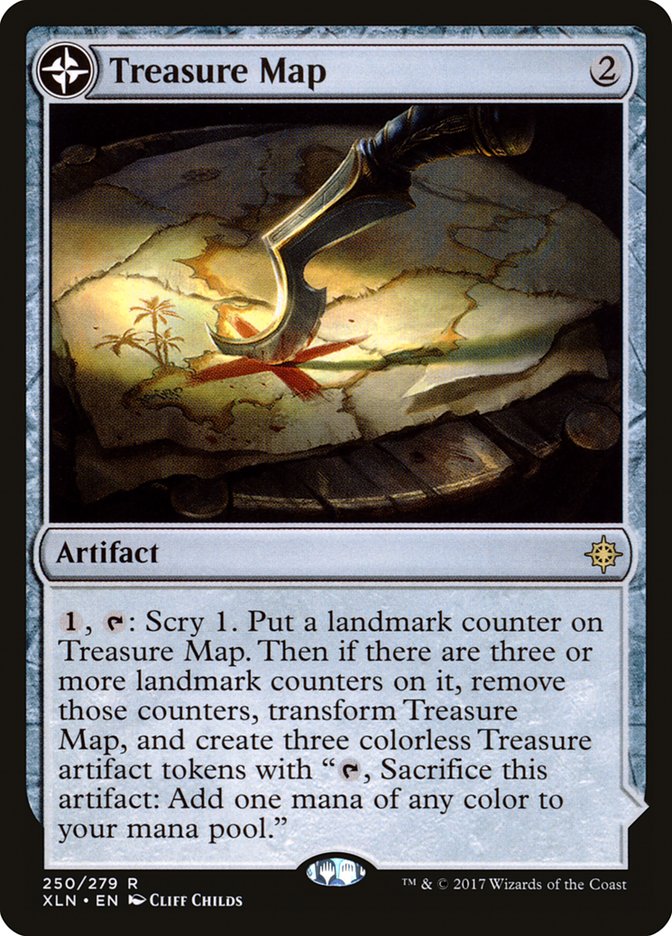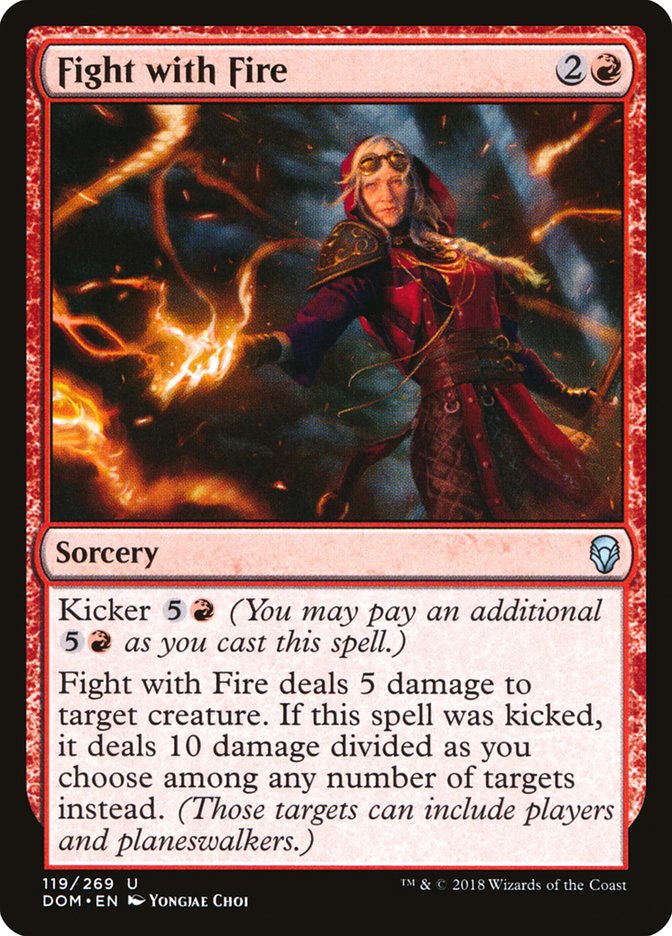…And Goblin Chainwhirler is not. Think about that.
In case you missed the reference, there were several days early on in the
unbanning of Jace, the Mind Sculptor where I tweeted some aggressive
comparisons between cards that, in my opinion, did not deserve to be on the
banned list if Jace was out and about. Green Sun’s Zenith, Preordain, and
Ancient Den were my picks for outdated bans from an earlier era of the
format, cards that could easily be reintroduced with less upheaval than
Papa Jace. As it stands, Jace and Bloodbraid Elf are both currently present
in Modern in healthy numbers, and it would seem that there’s little need
for alarm there. People play what they love in Modern, and that’s part of
the format’s appeal.
This is not the case in Standard. We are fresh off a Pro Tour that saw
absolute domination from Goblin Chainwhirler and friends, to the point
where the Top 8 was even more skewed towards Red Aggro than Grand Prix
Birmingham’s. 28 Chainwhirlers in the Top 8 is no joke. Most of the
top-performing decks contained Goblin Chainwhirler as well. In the
aggregate, Goblin Chainwhirler decks outshone the other mainstream
strategies by a fair margin, and it stands to reason that at the
Invitational this coming weekend, it will be the most played non-land card
in the room.
I remember when Wizards of the Coast chose to ban Ramunap Ruins and
Rampaging Ferocidon alongside Attune with Aether and Rogue Refiner to try
to hammer Standard back into shape. Their rationale was that without Temur
Energy as a format policeman, Ramunap Red would immediately have taken the
reins as the best deck in Standard. Therefore, they wanted to soften it up
a little bit by banning the freeroll four or five damage it got to squeeze
out of the manabase every game, as well as the three-drop that prevented a
lot of counterplay in lifegain and token decks, decks like Vampires or
Abzan Procession that used cards like Legion’s Landing to great effect.
With the Ferocidon gone (a card which, keep in mind, wasn’t even a
mandatory maindeck four-of in most lists), it was theorized that it would
be easier for opposing creature decks to stabilize the battlefield by
throwing a few lifelinking bodies out there, and that counterplay would
lead to a healthier format. And in all honesty, that was accurate. Before Dominaria, the red decks were good, but they had a heck of a lot
of possible counterplay in the midrange decks with The Scarab God and
Vraska’s Contempt, as well as the U/R Gift deck that clogged the
battlefield with expendable creatures before executing a massive combo
turn.
Then Dominaria hit the scene. The U/B decks got usurped by U/W
decks that capitalized on Teferi, Hero of Dominaria and his strength
against The Scarab God, and a little Goblin with a neat
enters-the-battlefield ability came out of the woodwork to clean up the
rest of the would-be competition. Remember the token-based decks that
Wizards hoped would provide some counterplay to red now that Rampaging
Ferocidon wasn’t around to make them look silly?
Oops.
Red picked up a little bit of black mana to employ Unlicensed
Disintegration, Scrapheap Scrounger, and a few choice sideboard hitters
against the U/W decks, and that was all she wrote. Llanowar Elves and the
associated green decks could have provided some important
counterplay to Red, but all the one-toughness creatures just look
embarrassing when considering Goblin Chainwhirler. If Rampaging Ferocidon
were in the format instead of Chainwhirler, you’d have a legitimate contest
between green-based aggro decks and red ones, but this contest is just
comical when one deck has a built-in battlefield advantage engine attached
to a solid three-drop body.
Most of the U/B Midrange decks relied on Glint-Sleeve Siphoner as an early
must-answer threat that could keep cards flowing and apply pressure against
the control decks. They played Champion of Wits as a card selection engine
early and a way to pull ahead in grindy late games. Both cards are fairly
bad in a Chainwhirler world. You can maindeck them, but you run a
large risk doing so. Green decks were supposed to be dominant with Llanowar
Elves. That was made impossible when the opposition could cast whatever
creature or removal spell or vehicle on turn two followed by a Chainwhirler
to move the battlefield back to parity and eat up a free card on three.
White decks were supposed to get a huge boost with History of Benalia as a
great way to play either offense or defense in the early turns, depending
on what was required in the matchup. The tokens neither block Goblin
Chainwhirler well, nor attack through Chainwhirler well.
All these cards would be playable in a Rampaging Ferocidon format, but that
card is banned. Instead, we get to enjoy the diversity-throttling power of
a card that eats up a whole class of early-game creatures for breakfast.
When the biggest legitimate question of the format is “does R/B really want
to play Bomat Courier maindeck because it’s so incredibly powerful, even
though it lines up poorly against Chainwhirler?” that may be a sign of an
unhealthy Standard. When R/B decks play Cinder Barrens to fix their mana
because they simply must play at least 23 red sources to accommodate their
centerpiece, that may be a sign of an unhealthy Standard. When the formerly
discarded one-drop, Soul-Scar Mage, comes roaring back into Standard
because of both its synergy with and resilience to Goblin Chainwhirler’s
enters-the-battlefield ability, that may be a sign of an unhealthy
Standard.
What is to be done? Well, I’m not really an advocate for more bannings
after so many over the last eighteen months. There are certainly ways to
minimize Chainwhirler’s impact by building one’s deck to not be vulnerable.
The U/W Control deck does this best, of course, but the W/B midrange decks
are similarly resilient to the trigger. Any deck with Fatal Push and
Vraska’s Contempt is going to be at least solid against Chainwhirler, and
Mono-Black Control might be the deck to go up against it in the future. B/U
Midrange can sideboard into a deck that has plenty of game against Red,
with a potential curve of Fatal Push into Gifted Aetherborn into Doomfall
into Vraska’s Contempt into The Scarab God. I’d look to the black cards to
try to cover both Chainwhirler decks and Teferi decks, but it may not
actually be enough to fix the format pressures of the Goblin.
The biggest reason why we might not see the necessary metagame evolution to
push Goblin Chainwhirler out of vogue is the obviously overpowered God that
comes along with the more aggressive versions of Chainwhirler Red. See,
ordinarily the R/B Aggro decks would midrange-ify themselves in attempts to
gain an edge in the semi-mirrors. They’d go bigger, with more
Planeswalkers, more card advantage, and more flexible removal. Bomat
Courier would be squeezed out, and eventually there would come a time where
even Chainwhirler itself would leave the deck in favor of more Doomfalls or
Never. The problem is that the only clean answers to Hazoret the Fervent
are either four mana removal or the combo of Soul-Scar Mage + multiple burn
spells. You simply can’t play that much four-mana removal because you must
play some mix of Chandra, Torch of Defiance, Karn, Scion of Urza,
Rekindling Phoenix, Glorybringer, or your own Hazorets. In a format with
better cheap answers to Hazoret, like Grasp of Darkness, Tribute to Hunger,
Crackling Doom, Celestial Purge, and the like, you would see those answers
cycle into the metagame and push down the more aggressive versions of Red.
The midrange arms race could begin in earnest, and the metagame would move.
This can’t happen when the only answers to Hazoret are also four mana. At
that point, you might as well play your own Hazorets! Hazoret demands cheap
spells, pushes down the other four-drop spells you can play, incentivizes
you to play Bomat Courier and Soul-Scar Mage (one, because Bomat helps you
empty your hand, and two, because Soul-Scar Mage is an adequate way to
answer enemy Hazorets), and dominates in the semi-mirrors. The combination
makes it awfully difficult to see any forthcoming metagame evolution on the
part of the Chainwhirler battles.
I should know; I registered three sideboard Vraska’s Contempts, three
Doomfalls, and a copy of The Eldest Reborn in an attempt to go over the
more aggressive Chainwhirler decks at the Pro Tour. It’s an angle, but it’s
overall still weak in game ones against Hazoret and needs to draw the right
mix of answers in games two and three. Owen Turtenwald had the right idea
by playing more Hazorets and leaning on the raw power of the card to win in
game one. Wyatt Darby leaned in even harder by just playing essentially
Mono-Red Aggro and winning the whole darn thing.
If you do decide to try to edge out the semi-mirror by going bigger, this
is the template I’d recommend. You can cut most of your creatures and leave
your opponent with dead removal and slower Hazorets in games two and three:
Creatures (13)
Planeswalkers (7)
Lands (26)
Spells (14)
Sideboard

In exchange for a neat sideboard plan against the semi-mirror, you cede
free win equity in game one against both R/B Aggro and U/W Control. Without
Hazoret to bail you out in the semi-mirror, you can’t just run them over.
Without Bomat Courier to fill you up with fresh cards against control, you
have a hard time finding a spot to stick a Planeswalker through the wall of
countermagic. In retrospect, this isn’t currently a format where you want
to go bigger; there are too many reasons to stay low to the ground.
Owen Turtenwald’s list from the Pro Tour is a fine place to start if you’d
like to experiment with the more aggressive version. I’m inclined to
believe that something close to this deck will be the best option for the
foreseeable future:
Creatures (23)
- 2 Pia Nalaar
- 4 Bomat Courier
- 4 Scrapheap Scrounger
- 2 Kari Zev, Skyship Raider
- 2 Glorybringer
- 3 Hazoret the Fervent
- 2 Soul-Scar Mage
- 4 Goblin Chainwhirler
Planeswalkers (3)
Lands (25)
Spells (9)
Sideboard

Bomat Courier is a very powerful card draw engine. Hazoret the Fervent is
an overpowered creature. Goblin Chainwhirler is a way to win for free
against a swath of the metagame. Just play your broken cards and enjoy
them.
One sideboard plan that I’d like to encourage as an option is a trio of
Treasure Maps and a pair of Fight with Fire. Treasure Map is a great way to
smooth out your sideboard draws against U/W Control, and lets you change
things up into a midrange deck a lot more effectively. Fight with Fire has
great synergy with the mana boost from Treasure Map as well as the free
lands from Settle the Wreckage. It’s not uncommon to be able to cast both
Duress and a kicked Fight with Fire in the same turn after sideboard after
a Settle the Wreckage. Combined with the fact that many U/W players choose
to cut some number of their Disallows after sideboarding to include more
two-mana interaction, and you have a recipe for success.
The extra Glorybringer, Unlicensed Disintegration, and Rekindling Phoenixes
aren’t super necessary, and could easily be shaved to make room for this
juke. Aside from that, Owen’s list looks as solid as anything I’d expect
from a player of his caliber. I won’t go as far as saying “play R/B Aggro
or be wrong” (as I’m not nearly as sagacious a Standard pundit as my
colleague Brad Nelson), but I won’t shy away from saying that it’s the best
deck right now. It’s hard to go wrong with the winning-est deck over
multiple professional-level events.
Just this weekend, on Twitter, Brian Braun-Duin asked his followers if
Rampaging Ferocidon would be more powerful than Goblin Chainwhirler in the
current Standard environment. The votes showed that the hive mind strongly
agrees that Ferocidon would be a much tamer substitution for Chainwhirler,
one that would allow a little more breathing room for a wide variety of
interesting decks. I’m inclined to agree, and recent tournament results
bear that out. Let’s see if things can shift out of this rut, or if we’ll
be cursed with another unfun Standard season and confidence-shaking banning
this summer.



